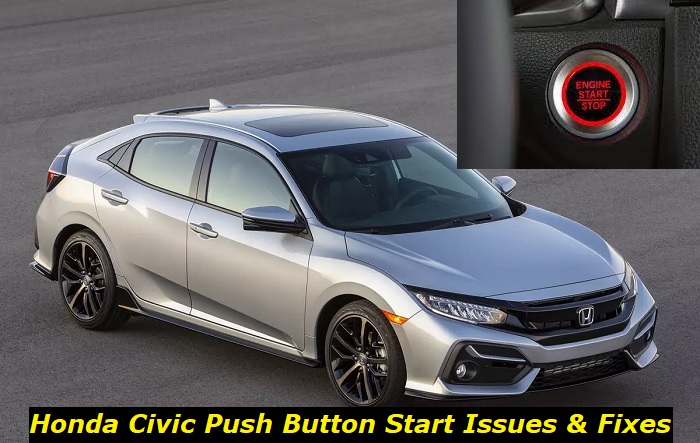The Push Start tech in cars such as the one equipped in the Honda Civic simplifies the process of cranking its engine. Instead of turning the ignition with a key, it can be done by simply pressing the button that corresponds to the feature and the brake pedal while you are carrying a key fob unique to your car.
There are cases though where it can fail. When it does, it can sometimes be hard to diagnose the cause of the problem because of the many components associated with the feature. In this article, we will give you an idea of the common reasons for this so you will have a quicker way of diagnosing and determining the right solution for the problem.

Without much ado, here are the most common causes of the issue and their respective fixes:
1. Key Fob Battery is Drained
Whenever you enter your Honda Civic, make sure that you have the key fob with you first. Then, see to it that it has enough power in its battery to communicate with your car. If the battery is drained, then it won't be able to send a signal to your car; thus, it won't allow you to start the engine.
To diagnose the problem, check if all of the other features on your key fob are still working. If they are not, then it is most likely due to a drained battery. This can easily be solved by replacing the battery in your key fob with a fresh one.
Make sure that you get batteries with the same size and voltage as recommended for your specific Honda Civic model. Be careful not to mix up positive and negative terminals when inserting new batteries into the key fob, and if you see signs of dirt in the terminals, simply rub them gently using a soft cloth.
Likewise, make sure that you seal it properly afterwards. Keep an eye on how long each replacement lasts and be sure to keep a spare battery on hand in case of emergencies.
If the key fob's features are still working and the battery is not drained yet the trouble persists, then you're advised to continue with your diagnosis with the other factors in this list.
2. Faulty Switch or Sensor in the Push Start Button and/or the Brake Pedal
It's important to ensure that the brake pedal is firmly pressed before using the Push Start function of your Honda Civic. However, if this fails, then you might be looking at potential issues in the switches or sensors in either the brake pedal or the Push Start button. In some cases, it may even be both.
The most common causes of this issue are related to the wiring and connections. When the circuit does not close properly, it can prevent the car from starting despite pressing both the brake pedal and the Push Start button. In some cases, it might be due to faulty parts such as a worn-out or damaged switch in either of the two components. This could also be caused by a disruption in the electrical system due to an attempted jump-start or other related issues.
To trace the source of this problem, you will have to observe certain symptoms such as lack of power when pressing either one of these two components, dashboard lights flickering when attempting to start, or even signs that there's still power running through them but no engine ignition.
Once you've identified the issue, a manual evaluation can help you identify specific components that may have worn down or been damaged. Using tools like a multimeter can help you confirm whether or not the switches have continuity or not.
To solve this problem, clean or replace any faulty parts such as the Push Start button mechanism or brake pedal switch. In some cases, it might even be necessary to replace both of them if they are not compatible with each other or if their connections have failed.
Next, check for any loose wires and make sure all connections are clean and secure before proceeding. After replacing the parts, test out your car again to make sure that the Push Start function is working normally and without any issues. If problems persist, then it might be necessary to look into other components of the electrical system.
Faulty switches or sensors in the Push Start button and/or brake pedal can cause issues with starting your vehicle. By being aware of the symptoms, evaluating parts manually, and using tools such as a multimeter, you can help narrow down where exactly the problem lies.
Additionally, replacing any worn-out or damaged parts is likely necessary for solving this issue so that your car can start normally again without any problems.
3. Starter Failure
The starter in the Honda Civic is a critical part of the vehicle's electrical system and plays an important role in allowing the car to be started. The starter receives power from the battery and sends it to activate other components, including sending a spark to ignite the fuel/air mixture for combustion. When this process does not work correctly, it can prevent you from using the Push Start function of your car.
One common cause of starter failure is a damaged solenoid, which is responsible for controlling current flow into the starter motor. Age-related wear and tear or improper maintenance can lead to corrosion of parts such as a worn-out battery cable or bad connection between contacts on electrical components, too. If any of these issues are present, the starter will likely need to be replaced.
To assess the source of the problem, you should first recognize any symptoms such as grinding or whining noise when attempting to start the car, followed by visual inspections for signs of worn parts. In order to further test any suspected components, tools like a multimeter and voltmeter can help determine if there is an electrical issue present.
If your starter needs a replacement, you will likely require a set of tools and some automotive experience in order to do so safely and correctly. Depending on the specific Honda Civic model and year, the exact parts necessary for replacement may vary.
However, all starters typically consist of solenoid contacts and wires, mounting bolts/nuts, and a starter motor. The exact dimensions and specifications of the parts must be checked before purchasing replacements.
In addition, it is important to ensure that all other components such as the battery cables are in good condition and not contributing to the problem.
Once you have replaced your Honda Civic starter, it should now work correctly, allowing you to use the Push Start function of your car without any problems. However, regular maintenance of all vehicle systems is recommended to keep your car running smoothly for many years to come.
4. Malfunction in the Vehicle Charging System
Issues in the vehicle charging system, usually those related to battery or alternator failure, can prevent drivers from using the Push Start function of their Honda Civic. To assess the root of the problem, drivers need to recognize its symptoms and conduct a visual check-up of their vehicle's charging system.
Apart from the battery and alternator, this should include inspecting the cables connected to them for signs of damage as well as looking out for any unusual noises while running.
Moreover, a multimeter tester should be used to measure voltage output at the terminals. If low voltage is observed following these steps, then there may be an issue with the battery, alternator, or some other part of the charging system that needs repair or replacement.
Replacing the battery is a pretty straightforward process, but a damaged alternator can be trickier to fix in most instances. The common replacement parts in the event of an alternator failure include the brushes, diode trio, and a voltage regulator.
If any of these components are found to be damaged or faulty, it is important to replace them with genuine Honda Civic parts as they can better withstand wear and tear over extended periods. Lastly, even after repair work has been completed, you should still test your vehicle's charging system regularly to ensure that it is functioning properly.
This way, you can reduce the risk of being unable to start your car due to charging system issues.
Drivers need to be aware of the potential risks associated with vehicle charging systems. By understanding the common causes of this issue, recognizing its symptoms, and performing regular checks, you can ensure that your Honda Civic's Push Start function remains available at all times. This in turn helps save money on costly repairs as well as costly tow truck fees.
Furthermore, when replacing parts such as brushes, diodes trio, or voltage regulator, you should always opt for genuine Honda Civic products as these are designed to better withstand wear and tear over long periods.
Taking these steps will also help maintain your car's performance and reliability throughout its life span. As such, you can guarantee that your Honda Civic provides the best driving experience possible.
Conclusion
There are a lot of things that can trigger a malfunction in the Push Start button of your Honda Civic. However, the factors contained here are among the most common and should provide you with a good starting point for your diagnosis.
No matter what, be sure to be guided by a professional mechanic or automotive technician as you apply the possible solutions here to ensure your success in fixing the issue.
About the authors
The CarAraC research team is composed of seasoned auto mechanics and automotive industry professionals, including individuals with advanced degrees and certifications in their field. Our team members boast prestigious credentials, reflecting their extensive knowledge and skills. These qualifications include: IMI: Institute of the Motor Industry, ASE-Certified Master Automobile Technicians; Coventry University, Graduate of MA in Automotive Journalism; Politecnico di Torino, Italy, MS Automotive Engineering; Ss. Cyril and Methodius University in Skopje, Mechanical University in Skopje; TOC Automotive College; DHA Suffa University, Department of Mechanical Engineering






Add comment